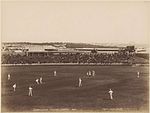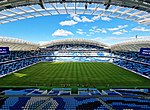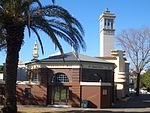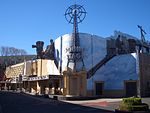Sydney Cricket Ground Members' Stand and Lady Members' Stand
Moore Park, New South WalesNew South Wales State Heritage RegisterParks in New South WalesSydney Cricket GroundUse Australian English from October 2018

The Members’ Stand and Lady Members’ Stand at the Sydney Cricket Ground are two heritage-listed grandstands located at Driver Avenue in the inner eastern Sydney suburb of Moore Park in the City of Sydney local government area of New South Wales, Australia. It was designed by J. Kirkpatrick and built from 1900. The property is owned by the Sydney Cricket and Sports Ground Trust, an agency of the Government of New South Wales. It was added to the New South Wales State Heritage Register on 2 April 1999.The area occupied by the stands were previously Aboriginal land, a water reserve, community facility, showground, and cricket ground.
Excerpt from the Wikipedia article Sydney Cricket Ground Members' Stand and Lady Members' Stand (License: CC BY-SA 3.0, Authors, Images).Sydney Cricket Ground Members' Stand and Lady Members' Stand
John Hargreaves Avenue, Sydney Moore Park
Geographical coordinates (GPS) Address Website Nearby Places Show on map
Geographical coordinates (GPS)
| Latitude | Longitude |
|---|---|
| N -33.8909 ° | E 151.2246 ° |
Address
Sydney Cricket Ground
John Hargreaves Avenue
2021 Sydney, Moore Park
New South Wales, Australia
Open on Google Maps








